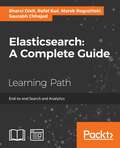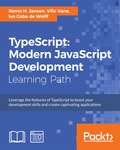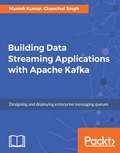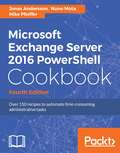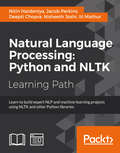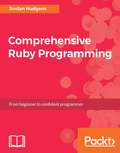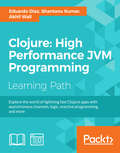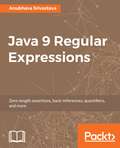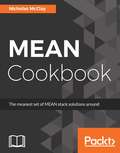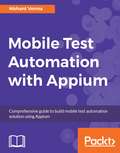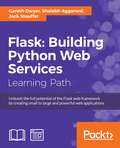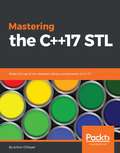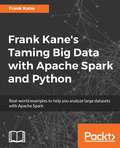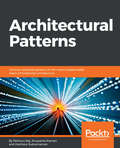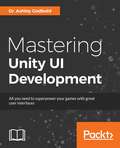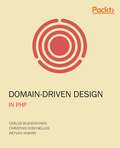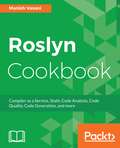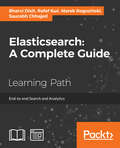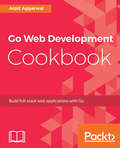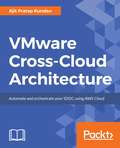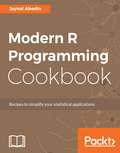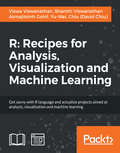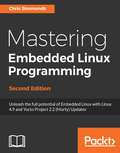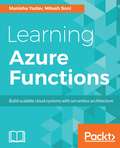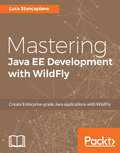- Table View
- List View
Elasticsearch: A Complete Guide
by Saurabh Chhajed Rafal Kuc Marek Rogozinski Bharvi DixitEnd-to-end Search and Analytics About This Book • Solve your data analytics problems with the Elastic Stack • Improve your user search experience with Elasticsearch and develop your own Elasticsearch plugins • Design your index, configure it, and distribute it — you'll also learn how it works Who This Book Is For This course is for anyone who wants to build efficient search and analytics applications. Some development experience is expected. What You Will Learn • Install and configure Elasticsearch, Logstash, and Kibana • Write CRUDE operations and other search functionalities using the Elasticsearch Python and Java Clients • Build analytics using aggregations • Set up and scale Elasticsearch clusters using best practices • Master document relationships and geospatial data • Build your own data pipeline using Elastic Stack • Choose the appropriate amount of shards and replicas for your deployment • Become familiar with the Elasticsearch APIs In Detail Elasticsearch is a modern, fast, distributed, scalable, fault tolerant, open source search and analytics engine. It provides a new level of control over how you can index and search even huge sets of data. This course will take you from the basics of Elasticsearch to using Elasticsearch in the Elastic Stack and in production. You'll start with the very basics: Elasticsearch terminology, installation, and configuring Elasticsearch. After this, you'll take a look at analytics and indexing, search, and querying. You'll learn how to create maps and visualizations. You'll also be briefed on cluster scaling, search and bulk operations, backups, and security. Then you'll be ready to get into Elasticsearch's internal functionalities including caches, Apache Lucene library, and its monitoring capabilities. You'll learn about the practical usage of Elasticsearch configuration parameters and how to use the monitoring API. You'll discover how to improve the user search experience, index distribution, segment statistics, merging, and more. Once you have mastered this, you'll dive into end-to-end visualize-analyze-log techniques with Elastic Stack (also known as the ELK stack). You'll explore Elasticsearch, Logstash, and Kibana and see how to make them work together to build fresh insights and business metrics out of data. You'll be able to use Elasticsearch with other de facto components in order to get the most out of Elasticsearch. By the end of this course, you'll have developed a full-fledged data pipeline. This Learning Path combines some of the best that Packt has to offer in one complete, curated package. It includes content from the following Packt products: • Elasticsearch Essentials • Mastering Elasticsearch, Second Edition • Learning ELK Stack Style and approach This course aims to create a smooth learning path that will teach you how to effectively use Elasticsearch with other de facto components and get the most out of Elasticsearch. Through this comprehensive course, you'll learn the basics of Elasticsearch and progress to using Elasticsearch in the Elastic stack and in production.
TypeScript: Modern JavaScript Development
by Ivo Gabe Wolff Remo H. Jansen Vilic VaneLeverage the features of TypeScript to boost your development skills and create captivating applications About This Book • Learn how to develop modular, scalable, maintainable, and adaptable web applications by taking advantage of TypeScript • Explore techniques to use TypeScript alongside other leading tools such as Angular 2, React, and Node.js • Focusing on design patterns in TypeScript, this step-by-step guide demonstrates all the important design patterns in practice Who This Book Is For This Learning Path is for intermediate-level JavaScript developers who want to use TypeScript to build beautiful web applications and fun projects. No prior knowledge of TypeScript is required, but a basic understanding of jQuery is expected. This Learning Path is also for experienced TypeScript developers who want to take their skills to the next level, and also for web developers who wish to make the most of TypeScript. What You Will Learn • Understand the key TypeScript language features and runtime • Install and configure the necessary tools in order to start developing an application • Create object-oriented code that adheres to the SOLID principles • Develop robust applications with testing (Mocha, Chai, and SinonJS) • Apply GoF patterns in an application with a testing approach • Identify the challenges when developing an application • Migrate JavaScript codebases to TypeScript to improve your workflow • Utilize System.JS and Webpack to load scripts and their dependencies • Develop high performance server-side applications to run within Node.js In Detail TypeScript is an open source and cross-platform typed superset of JavaScript that compiles to plain JavaScript that runs in any browser or any host. TypeScript adds optional static types, classes, and modules to JavaScript, to enable great tooling and better structuring of large JavaScript applications. Through this three-module learning path, you'll learn the ins-and-outs of TypeScript for building more robust software. The first module gets you started with TypeScript and helps you understand the basics of TypeScript and automation tools. Get a detailed description of function, generics, callbacks, and promises, and discover the object-oriented features and memory management functionality of TypeScript. The next module starts by explaining the current challenges when designing and developing an application and how you can solve these challenges by applying the correct design pattern and best practices. You will be introduced to low-level programming concepts to help you write TypeScript code, as well as working with software architecture, best practices, and design aspects. The final module will help you build a complete single page app with Angular 2, create a neat mobile app using NativeScript, and even build a Pac Man game with TypeScript. As if the fun wasn't enough, you'll also find out how to migrate your legacy codebase from JavaScript to TypeScript. By the end of this Learning Path, you will be able to take your skills up a notch and develop full-fledged web applications using the latest features of the TypeScript. This Learning Path combines some of the best that Packt has to offer in one complete, curated package. It includes content from the following Packt products: • Learning TypeScript by Remo H. Jansen • TypeScript Design Patterns by Vilic Vane • TypeScript Blueprints by Ivo Gabe de Wolff Style and approach This is a step-by-step, practical guide covering the fundamentals of TypeScript with practical examples. The end-to-end projects included in this book will give you ready-to-implement solutions for your business scenario, showcasing the depth and robustness of TypeScript.
Building Data Streaming Applications with Apache Kafka
by Chanchal Singh Manish KumarDesign and administer fast, reliable enterprise messaging systems with Apache Kafka About This Book • Build efficient real-time streaming applications in Apache Kafka to process data streams of data • Master the core Kafka APIs to set up Apache Kafka clusters and start writing message producers and consumers • A comprehensive guide to help you get a solid grasp of the Apache Kafka concepts in Apache Kafka with pracitcalpractical examples Who This Book Is For If you want to learn how to use Apache Kafka and the different tools in the Kafka ecosystem in the easiest possible manner, this book is for you. Some programming experience with Java is required to get the most out of this book What You Will Learn • Learn the basics of Apache Kafka from scratch • Use the basic building blocks of a streaming application • Design effective streaming applications with Kafka using Spark, Storm &, and Heron • Understand the importance of a low -latency , high- throughput, and fault-tolerant messaging system • Make effective capacity planning while deploying your Kafka Application • Understand and implement the best security practices In Detail Apache Kafka is a popular distributed streaming platform that acts as a messaging queue or an enterprise messaging system. It lets you publish and subscribe to a stream of records, and process them in a fault-tolerant way as they occur. This book is a comprehensive guide to designing and architecting enterprise-grade streaming applications using Apache Kafka and other big data tools. It includes best practices for building such applications, and tackles some common challenges such as how to use Kafka efficiently and handle high data volumes with ease. This book first takes you through understanding the type messaging system and then provides a thorough introduction to Apache Kafka and its internal details. The second part of the book takes you through designing streaming application using various frameworks and tools such as Apache Spark, Apache Storm, and more. Once you grasp the basics, we will take you through more advanced concepts in Apache Kafka such as capacity planning and security. By the end of this book, you will have all the information you need to be comfortable with using Apache Kafka, and to design efficient streaming data applications with it. Style and approach A step-by –step, comprehensive guide filled with practical and real- world examples
Microsoft Exchange Server 2016 PowerShell Cookbook - Fourth Edition
by Nuno Mota Mike Pfeiffer Jonas AnderssonMake the most of PowerShell's features to manage all aspects of your Exchange Server 2016 environment. About This Book • Learn to integrate PowerShell with Exchange Server 2016 • Write scripts and functions to run tasks automatically, and generate complex reports with PowerShell • Use these effective recipes to learn all popular and important PowersShell scripts to manage tasks and avoid errors Who This Book Is For This book is for messaging professionals who want to build real-world scripts with Windows PowerShell and the Exchange Management Shell. You'll also find it indispensable if you're a network or systems administrator responsible for managing and maintaining Exchange Server 2016. What You Will Learn • Master the new features and capabilities of PowerShell and Exchange Server 2016 • Get to grips with the core PowerShell concepts • Use simple PowerShell scripts and commands to get powerful results • Generate detailed reports, send the output of commands by email , and schedule scripts to run automatically • Import, export, and move mailboxes, and delete messages from mailboxes using the command line • Configure transport server settings such as mail relay, tracking logs, transport rules, delivery reports, and more • Manage mailbox and public folders • Monitor the health of an Exchange environment through built-in cmdlets and other methods • Integrate Exchange with Office Online Server, Skype for Business Server, and Exchange Online (Office 365) In Detail We start with a set of recipes on core PowerShell concepts. This will provide you with a foundation for the examples in the book. Next, you'll see how to implement some of the common exchange management shell tasks, so you can effectively write scripts with this latest release. You will then learn to manage Exchange recipients, automate recipient-related tasks in your environment, manage mailboxes, and understand distribution group management within the Exchange Management Shell. Moving on, we'll work through several scenarios where PowerShell scripting can be used to increase your efficiency when managing databases, which are the most critical resources in your Exchange environment. Towards the end, you'll discover how to achieve Exchange High Availability and how to secure your environment, monitor the health of Exchange, and integrate Exchange with Office Online Server, Skype for Business Server, and Exchange Online (Office 365). By the end of the book, you will be able to perform administrative tasks efficiently. Style and approach This practical guide is packed with handy recipes to help you perform common administration tasks, as well as complex tasks in Exchange Server, without any hassle.
Natural Language Processing: Python and NLTK
by Nitin Hardeniya Nisheeth Joshi Jacob Perkins Iti Mathur Deepti ChopraLearn to build expert NLP and machine learning projects using NLTK and other Python libraries About This Book * Break text down into its component parts for spelling correction, feature extraction, and phrase transformation * Work through NLP concepts with simple and easy-to-follow programming recipes * Gain insights into the current and budding research topics of NLP Who This Book Is For If you are an NLP or machine learning enthusiast and an intermediate Python programmer who wants to quickly master NLTK for natural language processing, then this Learning Path will do you a lot of good. Students of linguistics and semantic/sentiment analysis professionals will find it invaluable. What You Will Learn * The scope of natural language complexity and how they are processed by machines * Clean and wrangle text using tokenization and chunking to help you process data better * Tokenize text into sentences and sentences into words * Classify text and perform sentiment analysis * Implement string matching algorithms and normalization techniques * Understand and implement the concepts of information retrieval and text summarization * Find out how to implement various NLP tasks in Python In Detail Natural Language Processing is a field of computational linguistics and artificial intelligence that deals with human-computer interaction. It provides a seamless interaction between computers and human beings and gives computers the ability to understand human speech with the help of machine learning. The number of human-computer interaction instances are increasing so it's becoming imperative that computers comprehend all major natural languages. The first NLTK Essentials module is an introduction on how to build systems around NLP, with a focus on how to create a customized tokenizer and parser from scratch. You will learn essential concepts of NLP, be given practical insight into open source tool and libraries available in Python, shown how to analyze social media sites, and be given tools to deal with large scale text. This module also provides a workaround using some of the amazing capabilities of Python libraries such as NLTK, scikit-learn, pandas, and NumPy. The second Python 3 Text Processing with NLTK 3 Cookbook module teaches you the essential techniques of text and language processing with simple, straightforward examples. This includes organizing text corpora, creating your own custom corpus, text classification with a focus on sentiment analysis, and distributed text processing methods. The third Mastering Natural Language Processing with Python module will help you become an expert and assist you in creating your own NLP projects using NLTK. You will be guided through model development with machine learning tools, shown how to create training data, and given insight into the best practices for designing and building NLP-based applications using Python. This Learning Path combines some of the best that Packt has to offer in one complete, curated package and is designed to help you quickly learn text processing with Python and NLTK. It includes content from the following Packt products: * NTLK essentials by Nitin Hardeniya * Python 3 Text Processing with NLTK 3 Cookbook by Jacob Perkins * Mastering Natural Language Processing with Python by Deepti Chopra, Nisheeth Joshi, and Iti Mathur Style and approach This comprehensive course creates a smooth learning path that teaches you how to get started with Natural Language Processing using Python and NLTK. You'll learn to create effective NLP and machine learning projects using Python and NLTK.
Comprehensive Ruby Programming
by Jordan HudgensThis book will provide you with all of the tools you need to be a professional Ruby developer. Starting with the core principles, such as syntax and best practices, and up to advanced topics like metaprogramming and big data analysis. About This Book • Provides the core skills required to become a Ruby programmer • Covers how to use the most popular Ruby Gem libraries • Includes details on regular expressions Who This Book Is For This is a complete course written from the ground up for beginners wanting to gain a solid understanding of the Ruby language. It starts at the beginning with how to install Ruby and work with it on multiple machines, so simply have a computer that's connected to the Internet and you'll be ready. What You Will Learn • Learn how to use Ruby code effectively, picking the right tool for the job and not duplicating built-in functionality • Gain best software development practices, and how to identify and fix common errors • Absorb core programming skills, such as variables, strings, loops, conditionals, and much more • Explore object-oriented programming and learn to create modular, reusable code that you can use across projects • Build 10 practical Ruby programs as you work through the book on topics such as big data analysis and solving Euler equations In Detail Ruby is a powerful, general-purpose programming language that can be applied to any task. Whether you are an experienced developer who wants to learn a new language or you are new to programming, this book is your comprehensive Ruby coding guide. Starting with the foundational principles, such as syntax, and scaling up to advanced topics such as big data analysis, this book will give you all of the tools you need to be a professional Ruby developer. A few of the key topics are: object-oriented programming, built-in Ruby methods, core programming skills, and an introduction to the Ruby on Rails and Sinatra web frameworks. You will also build 10 practical Ruby programs. Created by an experienced Ruby developer, this book has been written to ensure it focuses on the skills you will need to be a professional Ruby developer. After you have read this book, you will be ready to start building real-world Ruby projects. Style and approach This is a comprehensive course for learning the Ruby programming language that works methodically through everything that you need to know. It begins with the basics of the language and then works through some complete projects to apply your skills and ensure that you have fully absorbed them and can use them in the real world.
Clojure: High Performance JVM Programming
by Shantanu Kumar Eduardo Diaz Akhil WaliExplore the world of lightning fast Clojure apps with asynchronous channels, logic, reactive programming, and more About This Book • Discover Clojure's features and advantages and use them in your existing projects • Explore lesser-known and more advanced features, constructs, and methodologies such as asynchronous channels, actors, logic programming, and reactive programming • Measure and monitor performance, and understand optimization techniques Who This Book Is For If you're looking to learn more about its core libraries and delve into the Clojure language in detail, then this book is ideal for you. Prior knowledge of the Clojure language is required. What You Will Learn • Understand tools for the Clojure world and how they relate to Java tools and standards (such as Maven) • Write simple multicore programs using Clojure's core concepts, such as atoms, agents, and refs • Get to grips with Clojure's concurrency and state-management primitives in depth • Analyze latency using the Criterium library • Avoid reflection and boxing with type hints • Maximize the impact of parallelization, functional composition, and process transformation by composing reducers and transducers • Modify and add features to the Clojure language using macros • Test your code with unit tests, specs, and type checks to write testable code • Troubleshoot and style your Clojure code to make it more maintainable In Detail Clojure is a general-purpose language from the Lisp family with an emphasis on functional programming. It has some interesting concepts and features such as immutability, gradual typing, thread-safe concurrency primitives, and macro-based metaprogramming, which makes it a great choice to create modern, performant, and scalable applications. This learning path aims at unleashing the true potential of the Clojure language so you can use it in your projects. It begins with installing and setting up the Clojure environment before moving on to explore the language in depth. You'll get acquainted with its various features such as functional programming, concurrency, reducers, transducers, core.async and core.logic, and so on with a great level of detail. Moving on, you'll also learn how to enhance performance using Java interoperability and JVM-specific features from Clojure; you'll even master language features such as asynchronous channels, actors, logic programming, reactive programming, metaprogramming, and so on. This learning path combines some of the best that Packt has to offer in one complete, curated package. It includes content from the following Packt products: • Clojure for Java Developers by Eduardo Diaz • Clojure High Performance Programming, Second Edition by Shantanu Kumar • Mastering Clojure by Akhil Wali Style and approach This is an easy-to-follow, step-by-step guide to start writing Clojure programs, making use of all of its varied features and advantages.
Java 9 Regular Expressions
by Anubhava SrivastavaSolve real world problems using Regex in Java. About This Book • Discover regular expressions and how they work • Implement regular expressions with Java to your code base • Learn to use regular expressions in emails, URLs, paths, and IP addresses Who This Book Is For This book is for Java developers who would like to understand and use regular expressions. A basic knowledge of Java is assumed. What You Will Learn • Understand the semantics, rules, and core concepts of writing Java code involving regular expressions • Learn about the java.util.Regex package using the Pattern class, Matcher class, code snippets, and more • Match and capture text in regex and use back-references to the captured groups • Explore Regex using Java String methods and regex capabilities in the Java Scanner API • Use zero-width assertions and lookarounds in regex • Test and optimize a poorly performing regex and various other performance tips In Detail Regular expressions are a powerful tool in the programmer's toolbox and allow pattern matching. They are also used for manipulating text and data. This book will provide you with the know-how (and practical examples) to solve real-world problems using regex in Java. You will begin by discovering what regular expressions are and how they work with Java. This easy-to-follow guide is a great place from which to familiarize yourself with the core concepts of regular expressions and to master its implementation with the features of Java 9. You will learn how to match, extract, and transform text by matching specific words, characters, and patterns. You will learn when and where to apply the methods for finding patterns in digits, letters, Unicode characters, and string literals. Going forward, you will learn to use zero-length assertions and lookarounds, parsing the source code, and processing the log files. Finally, you will master tips, tricks, and best practices in regex with Java. Style and approach This book will take readers through this learning journey using simple, easy-to-understand, step-by-step instructions and hands-on examples at every stage.
MEAN Cookbook
by Nicholas McclayOver 50 recipes to create full-stack high-performance web applications using pure JavaScript and the MEAN stack. About This Book • Architect a fully functional stand-alone web application, including the web server, database, and front-end web application • Improve the performance and maintainability of your MEAN stack application with tips for configuration and optimization • Highlights MEAN Stack best practices when working with your application Who This Book Is For If you are a JavaScript developer who wants to create high-performing, modern web applications with the MEAN stack, this is the book for you. Web developers familiar with some parts of the MEAN stack will find this a comprehensive guide to fleshing out the other technologies and skills they need to build all JavaScript web applications. Developers interested in transitioning from other web application stacks to an all-JavaScript environment will find a wealth of information about how to work in a MEAN stack environment. To get the most from this book, you should have a general understanding of web servers and web applications. You are expected to have a basic understanding of running JavaScript, both in a web browser and outside it, using Node.js and the NPM package manager. What You Will Learn • Bootstrap a new MEAN stack web application using Node.js and Express • Build a single-page application (SPA) with Angular and Angular-CLI • Improve browser performance by optimizing your web application resources using Webpack • Model complex JSON object relationships in MongoDB using Mongoose • Debug all the layers of a MEAN stack application, including working with source maps • Build Restful APIs using Express.js and JSON Web Token (JWT) for user authentication • Use automated testing to improve the reliability and quality of your MEAN stack application In Detail The MEAN Stack is a framework for web application development using JavaScript-based technologies; MongoDB, Express, Angular, and Node.js. If you want to expand your understanding of using JavaScript to produce a fully functional standalone web application, including the web server, user interface, and database, then this book can help guide you through that transition. This book begins by configuring the frontend of the MEAN stack web application using the Angular JavaScript framework. We then implement common user interface enhancements before moving on to configuring the server layer of our MEAN stack web application using Express for our backend APIs. You will learn to configure the database layer of your MEAN stack web application using MongoDB and the Mongoose framework, including modeling relationships between documents. You will explore advanced topics such as optimizing your web application using WebPack as well as the use of automated testing with the Mocha and Chai frameworks. By the end of the book, you should have acquired a level of proficiency that allows you to confidently build a full production-ready and scalable MEAN stack application. Style and Approach This book is a guide of MEAN Stack specific solutions to common web application problems and includes in-depth guides for each layer of the application stack. Readers looking to upgrade their MEAN Stack web application will find recipes within to help them transition.
Mobile Test Automation with Appium
by Nishant VermaAutomate your mobile app testing About This Book • How to automate testing with Appium • Apply techniques for creating comprehensive tests • How to test on physical devices or emulators Who This Book Is For Are you a mobile developer or a software tester who wishes to use Appium for your test automation? If so, then this is the right book for you .You must have basic Java programming knowledge. You don't need to have prior knowledge of Appium. What You Will Learn • Discover Appium and how to set up an automation framework for mobile testing • Understand desired capabilities and learn to find element locators • Learn to automate gestures and synchronize tests using Appium • Take an incremental approach to implement page object pattern • Learn to run Appium tests on emulators or physical devices • Set up Jenkins to run mobile automation tests by easy to learn steps • Discover tips and tricks to record video of test execution, inter app automation concepts • Learn to run Appium tests in parallel on multiple devices simultaneously In Detail Appium is an open source test automation framework for mobile applications. It allows you to test all three types of mobile applications: native, hybrid, and mobile web. It allows you to run the automated tests on actual devices, emulators, and simulators. Today, when every mobile app is made on at least two platforms, iOS and Android, you need a tool that allows you to test across platforms. Having two different frameworks for the same app increases the cost of the product and time to maintain it as well. Appium helps save this cost. With mobile app growth exploding, mobile app automation is mainstream now. In this book, author Nishant Verma provides you with a firm grounding in the concepts of Appium while diving into how to set up appium & Cucumber-jvm test automation framework, implement page object design pattern, automate gestures, test execution on emulators and physical devices, and implement continuous integration with Jenkins. The mobile app we have referenced in this book is Quikr because of its relatively lower learning curve to understand the application. It's a local classifieds shopping app. Style and approach This book takes a practical, step-by-step approach to testing and automating individual apps such as native, hybrid, and mobile web apps using different examples.
Flask: Building Python Web Services
by Gareth Dwyer Shalabh Aggarwal Jack Stouffer<P><P>Unleash the full potential of the Flask web framework by creating small to large and powerful web applications <P><P>About This Book <P><P>Create your own world-class applications and master the art of Flask by unravelling its enigma through this journey <P><P>Packed with recipes containing lots of sample applications to help you understand the intricacies of Flask web programming <P><P>Work with scalable Flask application structures to create complex web apps <P><P>Who This Book Is For <P><P>This learning path is ideal developers who know the basics of Python and want to learn how to use the Flask framework to build powerful web solutions in Python. <P><P>What You Will Learn <P><P>Build three web applications from the ground up using the powerful Python micro framework, Flask. <P><P>Extend your applications to build advanced functionality, such as a user account control system using Flask-Login <P><P>Learn about web application security and defend against common attacks, such as SQL injection and XSS <P><P>Integrate with technologies like Redis, Sentry, MongoDB and so on <P><P>Build applications with integrations to most of the login mechanisms available <P><P>Don't just stop at development. Learn about deployment and post-deployment <P><P>Use SQLAlchemy to programmatically query a database <P><P>Develop a custom Flask extension <P><P>In Detail <P><P>Are you a fan of Python? Want to use it to create powerful web applications? Then Flask is the perfect choice for you. This course will take you through the intricacies of the Flask Microframework, covering all it's components and elements and how to integrate it with useful third party libraries. Dive deep into what Flask has to offer and then you will create multiple Python apps from scratch on your own. <P><P>The first module will introduce you to web development using Flask to building fully functional web applications. Hands-on and pragmatic, this tutorial goes right to the crux of Flask by showing you how to build challenging real-world applications. <P><P>The second module introduces you to a number of recipes that will help you understand the power of Flask and its extensions. Start by seeing the different configurations that a Flask application can make use of. By the end of this module, you will have gained all the knowledge required to write Flask applications in the best possible way, and scale them with best practices. <P><P>The final module will walk you through advanced Flask topics while providing practical examples of for all your lessons learned. The module closes with a discussion of the different platforms that are available to deploy a Flask app on, the pros and cons of each one, and how to deploy on each one. <P><P>This Learning Path combines some of the best that Packt has to offer in one complete, curated package. It includes content from the following Packt products: <P><P>Flask By-Example: Gareth Dwyer <P><P>Flask Framework Cookbook: Shalabh Aggarwal <P><P>Mastering Flask: Jack Stouffer <P><P>Style and approach <P><P>Filled with practical examples and recipes, this course is a great combination of example-driven learning complemented by exciting techniques to build powerful Python web applications with the Flask framework
Mastering the C++17 STL
by Arthur O'DwyerThis book breaks down the C++ STL, teaching you how to extract its gems and apply them to your programming. About This Book • Boost your productivity as a C++ developer with the latest features of C++17 • Develop high-quality, fast, and portable applications with the varied features of the STL • Migrate from older versions (C++11, C++14) to C++17 Who This Book Is For This book is for developers who would like to master the C++ STL and make full use of its components. Prior C++ knowledge is assumed. What You Will Learn • Make your own iterator types, allocators, and thread pools. • Master every standard container and every standard algorithm. • Improve your code by replacing new/delete with smart pointers. • Understand the difference between monomorphic algorithms, polymorphic algorithms, and generic algorithms. • Learn the meaning and applications of vocabulary type, product type and sum type. In Detail Modern C++ has come a long way since 2011. The latest update, C++17, has just been ratified and several implementations are on the way. This book is your guide to the C++ standard library, including the very latest C++17 features. The book starts by exploring the C++ Standard Template Library in depth. You will learn the key differences between classical polymorphism and generic programming, the foundation of the STL. You will also learn how to use the various algorithms and containers in the STL to suit your programming needs. The next module delves into the tools of modern C++. Here you will learn about algebraic types such as std::optional, vocabulary types such as std::function, smart pointers, and synchronization primitives such as std::atomic and std::mutex. In the final module, you will learn about C++'s support for regular expressions and file I/O. By the end of the book you will be proficient in using the C++17 standard library to implement real programs, and you'll have gained a solid understanding of the library's own internals. Style and approach This book takes a concise but comprehensive approach to explaining and applying the C++ STL, one feature at a time.
Frank Kane's Taming Big Data with Apache Spark and Python
by Frank KaneFrank Kane's hands-on Spark training course, based on his bestselling Taming Big Data with Apache Spark and Python video, now available in a book. Understand and analyze large data sets using Spark on a single system or on a cluster. About This Book • Understand how Spark can be distributed across computing clusters • Develop and run Spark jobs efficiently using Python • A hands-on tutorial by Frank Kane with over 15 real-world examples teaching you Big Data processing with Spark Who This Book Is For If you are a data scientist or data analyst who wants to learn Big Data processing using Apache Spark and Python, this book is for you. If you have some programming experience in Python, and want to learn how to process large amounts of data using Apache Spark, Frank Kane's Taming Big Data with Apache Spark and Python will also help you. What You Will Learn • Find out how you can identify Big Data problems as Spark problems • Install and run Apache Spark on your computer or on a cluster • Analyze large data sets across many CPUs using Spark's Resilient Distributed Datasets • Implement machine learning on Spark using the MLlib library • Process continuous streams of data in real time using the Spark streaming module • Perform complex network analysis using Spark's GraphX library • Use Amazon's Elastic MapReduce service to run your Spark jobs on a cluster In Detail Frank Kane's Taming Big Data with Apache Spark and Python is your companion to learning Apache Spark in a hands-on manner. Frank will start you off by teaching you how to set up Spark on a single system or on a cluster, and you'll soon move on to analyzing large data sets using Spark RDD, and developing and running effective Spark jobs quickly using Python. Apache Spark has emerged as the next big thing in the Big Data domain – quickly rising from an ascending technology to an established superstar in just a matter of years. Spark allows you to quickly extract actionable insights from large amounts of data, on a real-time basis, making it an essential tool in many modern businesses. Frank has packed this book with over 15 interactive, fun-filled examples relevant to the real world, and he will empower you to understand the Spark ecosystem and implement production-grade real-time Spark projects with ease. Style and approach Frank Kane's Taming Big Data with Apache Spark and Python is a hands-on tutorial with over 15 real-world examples carefully explained by Frank in a step-by-step manner. The examples vary in complexity, and you can move through them at your own pace.
Architectural Patterns: Uncover essential patterns in the most indispensable realm of enterprise architecture
by Pethuru Raj Chelliah Harihara Subramanian J Anupama Murali Dr Kayarvizhy NKey Features Use patterns to tackle communication, integration, application structure, and more Implement modern design patterns such as microservices to build resilient and highly available applications Choose between the MVP, MVC, and MVVM patterns depending on the application being built Book Description Enterprise Architecture (EA) is typically an aggregate of the business, application, data, and infrastructure architectures of any forward-looking enterprise. Due to constant changes and rising complexities in the business and technology landscapes, producing sophisticated architectures is on the rise. Architectural patterns are gaining a lot of attention these days. The book is divided in three modules. You'll learn about the patterns associated with object-oriented, component-based, client-server, and cloud architectures. The second module covers Enterprise Application Integration (EAI) patterns and how they are architected using various tools and patterns. You will come across patterns for Service-Oriented Architecture (SOA), Event-Driven Architecture (EDA), Resource-Oriented Architecture (ROA), big data analytics architecture, and Microservices Architecture (MSA). The final module talks about advanced topics such as Docker containers, high performance, and reliable application architectures. The key takeaways include understanding what architectures are, why they're used, and how and where architecture, design, and integration patterns are being leveraged to build better and bigger systems. What you will learn Understand how several architectural and design patterns work to systematically develop multitier web, mobile, embedded, and cloud applications Learn object-oriented and component-based software engineering principles and patterns Explore the frameworks corresponding to various architectural patterns Implement domain-driven, test-driven, and behavior-driven methodologies Deploy key platforms and tools effectively to enable EA design and solutioning Implement various patterns designed for the cloud paradigm
Mastering UI Development with Unity: An in-depth guide to developing engaging user interfaces with Unity 5, Unity 2017, and Unity 2018
by Ashley GodboldMaster Game UI system by creating captivating user interface components with Unity 5 through Unity 2018 and C#. Learn about UI texts, images, world space UI, mobile-specific UI and much more.Key FeaturesDevelop a game UI with both technical and aesthetic considerationsUse all the UI elements provided by Unity's UI systemStep-by-step examples of creating user interface components in the top game genresBook DescriptionA functional UI is an important component for player interaction in every type of video game. Along with imparting crucial statistical information to the player, the UI is also the window through which the player engages with the world established by the game. Unity's tools give you the opportunity to create complex and attractive UIs to make your game stand out.This book helps you realize the full potential of Unity's powerful tools to create the best UI for your games by walking you through the creation of myriad user interface components. Learn how to create visually engaging heads-up-displays, pause menus, health bars, circular progress bars, animated menus, and more. This book not only teaches how to lay out visual elements, but also how to program these features and implement them across multiple games of varying genres.While working through the examples provided, you will learn how to develop a UI that scales to multiple screen resolutions, so your game can be released on multiple platforms with minimal changes. What you will learnDesign principles and patterns for laying out elements in your UITechniques that allow your UI to scale appropriately in different resolutionsHow to use automatic layouts to streamline your UI building processProperties of the Event System and how to appropriately hook events to your UI elementsAccess the components and properties of UI elements via code Implement all of Unity's built-in UI elements as well as those provided by TextMeshPro Develop key UI components that are popularly used in multiple game genresAdd visual flare to user interfaces with the use of animation and particle effectsCreate a UI that displays in the Screen Space as well as World SpaceWho this book is forThis book is for anyone keen to improve their games via a great user interface with Unity's UI system. If you're looking for a book that explains how to develop specific user interfaces or that thoroughly explains how each of the individual Unity components work, this book is for you.
Domain-Driven Design in PHP
by Carlos Buenosvinos Christian Soronellas Keyvan AkbaryReal examples written in PHP showcasing DDD Architectural Styles, Tactical Design, and Bounded Context Integration About This Book • Focuses on practical code rather than theory • Full of real-world examples that you can apply to your own projects • Shows how to build PHP apps using DDD principles Who This Book Is For This book is for PHP developers who want to apply a DDD mindset to their code. You should have a good understanding of PHP and some knowledge of DDD. This book doesn't dwell on the theory, but instead gives you the code that you need. What You Will Learn • Correctly design all design elements of Domain-Driven Design with PHP • Learn all tactical patterns to achieve a fully worked-out Domain-Driven Design • Apply hexagonal architecture within your application • Integrate bounded contexts in your applications • Use REST and Messaging approaches In Detail Domain-Driven Design (DDD) has arrived in the PHP community, but for all the talk, there is very little real code. Without being in a training session and with no PHP real examples, learning DDD can be challenging. This book changes all that. It details how to implement tactical DDD patterns and gives full examples of topics such as integrating Bounded Contexts with REST, and DDD messaging strategies. In this book, the authors show you, with tons of details and examples, how to properly design Entities, Value Objects, Services, Domain Events, Aggregates, Factories, Repositories, Services, and Application Services with PHP. They show how to apply Hexagonal Architecture within your application whether you use an open source framework or your own. Style and approach This highly practical book shows developers how to apply domain-driven design principles to PHP. It is full of solid code examples to work through.
Roslyn Cookbook
by Manish VasaniUse Roslyn as a service to write powerful extensions and tools and use them in Visual Studio to improve code quality and maintain your source code more effectively. About This Book • Use Roslyn extensions and tools in Visual Studio to enforce "house rules" on code and fix security and performance vulnerabilities in your code. • Write Roslyn extensions using the Roslyn service API to help developers enforce conventions and design idioms. • Improve developer productivity by using Roslyn-based agile development features in Visual Studio, such as live unit testing, C# interactive and scripting. • Contribute to the C# language and compiler tool chain to analyze and edit code. Who This Book Is For .NET Developers and architects, who are interested in taking full advantage of the Roslyn based extensions and tools to improve the development processes, will find this book useful. Roslyn contributors, i.e. the producers and C# community developers, will also find this book useful What You Will Learn • Write extensions to analyze source code and report warnings and errors. • Edit C# source code to fix compiler/analyzer diagnostics or refactor source code. • Improve code maintenance and readability by using analyzers and code fixes. • Catch security and performance issues by using PUMA scan analyzers and FxCop analyzers. • Perform Live Unit tests in Visual Studio. • Use C# interactive and scripting in Visual Studio. • Design a new C# language feature and implement various compiler phases for a new language feature. • Write command line tools to analyze and edit C# code. In Detail Open-sourcing the C# and Visual Basic compilers is one of the most appreciated things by the .NET community, especially as it exposes rich code analysis APIs to analyze and edit code. If you want to use Roslyn API to write powerful extensions and contribute to the C# developer tool chain, then this book is for you. Additionally, if you are just a .NET developer and want to use this rich Roslyn-based functionality in Visual Studio to improve the code quality and maintenance of your code base, then this book is also for you. This book is divided into the following broad modules: 1. Writing and consuming analyzers/fixers (Chapters 1 - 5): You will learn to write different categories of Roslyn analyzers and harness and configure analyzers in your C# projects to catch quality, security and performance issues. Moving ahead, you will learn how to improve code maintenance and readability by using code fixes and refactorings and also learn how to write them. 2. Using Roslyn-based agile development features (Chapters 6 and 7): You will learn how to improve developer productivity in Visual Studio by using features such as live unit testing, C# interactive and scripting. 3. Contributing to the C# language and compiler tool chain (Chapters 8 - 10): You will see the power of open-sourcing the Roslyn compiler via the simple steps this book provides; thus, you will contribute a completely new C# language feature and implement it in the Roslyn compiler codebase. Finally, you will write simple command line tools based on the Roslyn service API to analyze and edit C# code. Style and approach This book takes a recipe-based approach, teaching you how to perform various hacks with the Compiler API in your hands.
Elasticsearch: A Complete Guide
by Bharvi Dixit<P><P>End-to-end Search and Analytics <P><P>About This Book <P><P>Solve your data analytics problems with the Elastic Stack <P><P>Improve your user search experience with Elasticsearch and develop your own Elasticsearch plugins <P><P>Design your index, configure it, and distribute it — you'll also learn how it works <P><P>Who This Book Is For <P><P>This course is for anyone who wants to build efficient search and analytics applications. Some development experience is expected. <P><P>What You Will Learn <P><P>Install and configure Elasticsearch, Logstash, and Kibana <P><P>Write CRUDE operations and other search functionalities using the Elasticsearch Python and Java Clients <P><P>Build analytics using aggregations <P><P>Set up and scale Elasticsearch clusters using best practices <P><P>Master document relationships and geospatial data <P><P>Build your own data pipeline using Elastic Stack <P><P>Choose the appropriate amount of shards and replicas for your deployment <P><P>Become familiar with the Elasticsearch APIs <P><P>In Detail <P><P>Elasticsearch is a modern, fast, distributed, scalable, fault tolerant, open source search and analytics engine. It provides a new level of control over how you can index and search even huge sets of data. This course will take you from the basics of Elasticsearch to using Elasticsearch in the Elastic Stack and in production. <P><P>You'll start with the very basics: Elasticsearch terminology, installation, and configuring Elasticsearch. After this, you'll take a look at analytics and indexing, search, and querying. You'll learn how to create maps and visualizations. You'll also be briefed on cluster scaling, search and bulk operations, backups, and security. <P><P>Then you'll be ready to get into Elasticsearch's internal functionalities including caches, Apache Lucene library, and its monitoring capabilities. You'll learn about the practical usage of Elasticsearch configuration parameters and how to use the monitoring API. You'll discover how to improve the user search experience, index distribution, segment statistics, merging, and more. <P><P>Once you have mastered this, you'll dive into end-to-end visualize-analyze-log techniques with Elastic Stack (also known as the ELK stack). You'll explore Elasticsearch, Logstash, and Kibana and see how to make them work together to build fresh insights and business metrics out of data. You'll be able to use Elasticsearch with other de facto components in order to get the most out of Elasticsearch. By the end of this course, you'll have developed a full-fledged data pipeline. <P><P>This Learning Path combines some of the best that Packt has to offer in one complete, curated package. It includes content from the following Packt products: <P><P>Elasticsearch Essentials <P><P>Mastering Elasticsearch, Second Edition <P><P>Learning ELK Stack <P><P>Style and approach <P><P>This course aims to create a smooth learning path that will teach you how to effectively use Elasticsearch with other de facto components and get the most out of Elasticsearch. Through this comprehensive course, you'll learn the basics of Elasticsearch and progress to using Elasticsearch in the Elastic stack and in production.
Go Web Development Cookbook: Build full-stack web applications with Go
by Arpit Aggarwal86 recipes on how to build fast, scalable, and powerful web services and applications with GoKey FeaturesBecome proficient in RESTful web servicesBuild scalable, high-performant web applications in GoGet acquainted with Go frameworks for web developmentBook DescriptionGo is an open source programming language that is designed to scale and support concurrency at the language level. This gives you the liberty to write large concurrent web applications with ease. From creating web application to deploying them on Amazon Cloud Services, this book will be your one-stop guide to learn web development in Go. The Go Web Development Cookbook teaches you how to create REST services, write microservices, and deploy Go Docker containers. Whether you are new to programming or a professional developer, this book will help get you up to speed with web development in Go. We will focus on writing modular code in Go; in-depth informative examples build the base, one step at a time. You will learn how to create a server, work with static files, SQL, NoSQL databases, and Beego. You will also learn how to create and secure REST services, and create and deploy Go web application and Go Docker containers on Amazon Cloud Services. By the end of the book, you will be able to apply the skills you've gained in Go to create and explore web applications in any domain.What you will learn Create a simple HTTP and TCP web server and understand how it works Explore record in a MySQL and MongoDB database Write and consume RESTful web service in Go Invent microservices in Go using Micro – a microservice toolkit Create and Deploy the Beego application with Nginx Deploy Go web application and Docker containers on an AWS EC2 instanceWho this book is forThis book is for Go developers interested in learning how to use Go to build powerful web applications. A background in web development is expected.
VMware Cross-Cloud Architecture: Automate and orchestrate your Software-Defined Data Center on AWS
by Ajit Pratap KundanEnhance your virtualization skills by mastering storage and network virtualization with automation across different CloudsKey FeaturesMigrate and build your applications in Hybrid Cloud with VMware Cross Cloud components and servicesGain in-depth configuration insights of VMware Cross Cloud architectureLearn to migrate applications from VMware to AWS and IBM CloudBook DescriptionOver the past two decades, VMware vSphere has been known as the most trusted andreliable virtualization platform. VMware Cross-Cloud Architecture shows you how to design and configure Cross Cloud Architecture by using VMware Cloud Foundation and vRealize Suite with various use cases across private, public, and hybrid Cloud. This book takes you through everything from a basic understanding of virtualization to advanced aspects of storage and network virtualization, clustering, automation, and management.This book will be your guide to designing all aspects of Cloud.We start with the challenges faced by a traditional data center, define problem statements for you, and then brief you on respective solutions. Moving on, all kinds of virtualization and Cloud offerings from AWS and IBM Soft Layer are introduced and discussed in detail. Then, you'll learn how to design IT infrastructures for new and existing applications with a combination of Cloud Foundation, vRealize Suite, and vSphere enabled with VSAN and NSX. Furthermore, you'll learn how to design and configure high availability, disaster recovery, and apply an appropriate compliance matrix.Toward the end of the book, you will learn how to calculate the TCO/ROI, along withthe VMware products packaging and licensing in detail.What you will learnInstall and configure the Cloud foundation with Cross-Cloud servicesConfigure vSphere high availability with the vCenter redundancy setupArchitect and configure VMware with AWS CloudDeploy VMware components in IBM Soft LayerExtend your DR setup with VMware to consume DRaaSDesign and configure software-defined networkingImplement compliance regulations to fix violationsWho this book is forThis book is for administrators, Cloud architects and network engineers who want to globalize their infrastructure using VMware and AWS services. An initial setup of workloads and data center is beneficial.
Modern R Programming Cookbook
by Jaynal AbedinRecipes for emerging developers in R programming and data scientists to simplify their R programming capabilities About This Book • Develop strategies to speed up your R code • Tackle programming problems and explore both functional and object-oriented programming techniques • Learn how to address the core problems of programming in R with the most popular R packages for common tasks Who This Book Is For This book is for developers who would like to enhance the R programming skills. Basic knowledge of R programming is assumed. What You Will Learn • Install R and its various IDE for a given platform along with installing libraries from different repositories and version control • Learn about basic data structures in R and how to work with them • Write customized R functions and handle recursions, exceptions in R environments • Create the data processing task as a step by step computer program and execute using dplyr • Extract and process unstructured text data • Interact with database management system to develop statistical applications • Formulate and implement parallel processing in R In Detail R is a powerful tool for statistics, graphics, and statistical programming. It is used by tens of thousands of people daily to perform serious statistical analyses. It is a free, open source system whose implementation is the collective accomplishment of many intelligent, hard-working people. There are more than 2,000 available add-ons, and R is a serious rival to all commercial statistical packages. The objective of this book is to show how to work with different programming aspects of R. The emerging R developers and data science could have very good programming knowledge but might have limited understanding about R syntax and semantics. Our book will be a platform develop practical solution out of real world problem in scalable fashion and with very good understanding. You will work with various versions of R libraries that are essential for scalable data science solutions. You will learn to work with Input / Output issues when working with relatively larger dataset. At the end of this book readers will also learn how to work with databases from within R and also what and how meta programming helps in developing applications. Style and approach This book will be a companion for R programmer and emerging developers in R programming areas. This book will contain recipes related to advanced R programming which will enable users to solve complex problems efficiently.
R: Recipes for Analysis, Visualization and Machine Learning
by Atmajitsinh Gohil Shanthi Viswanathan Viswa Viswanathan Yu-Wei ChiuGet savvy with R language and actualize projects aimed at analysis, visualization and machine learning About This Book * Proficiently analyze data and apply machine learning techniques * Generate visualizations, develop interactive visualizations and applications to understand various data exploratory functions in R * Construct a predictive model by using a variety of machine learning packages Who This Book Is For This Learning Path is ideal for those who have been exposed to R, but have not used it extensively yet. It covers the basics of using R and is written for new and intermediate R users interested in learning. This Learning Path also provides in-depth insights into professional techniques for analysis, visualization, and machine learning with R - it will help you increase your R expertise, regardless of your level of experience. What You Will Learn * Get data into your R environment and prepare it for analysis * Perform exploratory data analyses and generate meaningful visualizations of the data * Generate various plots in R using the basic R plotting techniques * Create presentations and learn the basics of creating apps in R for your audience * Create and inspect the transaction dataset, performing association analysis with the Apriori algorithm * Visualize associations in various graph formats and find frequent itemset using the ECLAT algorithm * Build, tune, and evaluate predictive models with different machine learning packages * Incorporate R and Hadoop to solve machine learning problems on big data In Detail The R language is a powerful, open source, functional programming language. At its core, R is a statistical programming language that provides impressive tools to analyze data and create high-level graphics. This Learning Path is chock-full of recipes. Literally! It aims to excite you with awesome projects focused on analysis, visualization, and machine learning. We'll start off with data analysis - this will show you ways to use R to generate professional analysis reports. We'll then move on to visualizing our data - this provides you with all the guidance needed to get comfortable with data visualization with R. Finally, we'll move into the world of machine learning - this introduces you to data classification, regression, clustering, association rule mining, and dimension reduction. This Learning Path combines some of the best that Packt has to offer in one complete, curated package. It includes content from the following Packt products: * R Data Analysis Cookbook by Viswa Viswanathan and Shanthi Viswanathan * R Data Visualization Cookbook by Atmajitsinh Gohil * Machine Learning with R Cookbook by Yu-Wei, Chiu (David Chiu) Style and approach This course creates a smooth learning path that will teach you how to analyze data and create stunning visualizations. The step-by-step instructions provided for each recipe in this comprehensive Learning Path will show you how to create machine learning projects with R.
Mastering Embedded Linux Programming - Second Edition
by Chris SimmondsMaster the techniques needed to build great, efficient embedded devices on Linux About This Book • Discover how to build and configure reliable embedded Linux devices • This book has been updated to include Linux 4.9 and Yocto Project 2.2 (Morty) • This comprehensive guide covers the remote update of devices in the field and power management Who This Book Is For If you are an engineer who wishes to understand and use Linux in embedded devices, this book is for you. It is also for Linux developers and system programmers who are familiar with embedded systems and want to learn and program the best in class devices. It is appropriate for students studying embedded techniques, for developers implementing embedded Linux devices, and engineers supporting existing Linux devices. What You Will Learn • Evaluate the Board Support Packages offered by most manufacturers of a system on chip or embedded module • Use Buildroot and the Yocto Project to create embedded Linux systems quickly and efficiently • Update IoT devices in the field without compromising security • Reduce the power budget of devices to make batteries last longer • Interact with the hardware without having to write kernel device drivers • Debug devices remotely using GDB, and see how to measure the performance of the systems using powerful tools such as perk, ftrace, and valgrind • Find out how to configure Linux as a real-time operating system In Detail Embedded Linux runs many of the devices we use every day, from smart TVs to WiFi routers, test equipment to industrial controllers - all of them have Linux at their heart. Linux is a core technology in the implementation of the inter-connected world of the Internet of Things. The comprehensive guide shows you the technologies and techniques required to build Linux into embedded systems. You will begin by learning about the fundamental elements that underpin all embedded Linux projects: the toolchain, the bootloader, the kernel, and the root filesystem. You'll see how to create each of these elements from scratch, and how to automate the process using Buildroot and the Yocto Project. Moving on, you'll find out how to implement an effective storage strategy for flash memory chips, and how to install updates to the device remotely once it is deployed. You'll also get to know the key aspects of writing code for embedded Linux, such as how to access hardware from applications, the implications of writing multi-threaded code, and techniques to manage memory in an efficient way. The final chapters show you how to debug your code, both in applications and in the Linux kernel, and how to profile the system so that you can look out for performance bottlenecks. By the end of the book, you will have a complete overview of the steps required to create a successful embedded Linux system. Style and approach This book is an easy-to-follow and pragmatic guide with in-depth analysis of the implementation of embedded devices. It follows the life cycle of a project from inception through to completion, at each stage giving both the theory that underlies the topic and practical step-by-step walkthroughs of an example implementation.
Learning Azure Functions
by Mitesh Soni Manisha YadavThis book will start with the basics of Azure Functions. You will learn the steps to set up the environment and the tools that we will be using in the further chapters. Once you have a better understanding of this, we will be creating our first hello world function app. Later you will be introduced to triggers, how they are used to activate a function, and how binding can be used to output results of a function.You will also explore the steps to create an assembly with complex functionality that can be used by functions. Next, this book will teach you to scale your functions and use them to process data, integrate systems, and build simple APIs and microservices. Finally, this book will cover some diagnostic techniques with Azure App services and best practices of working with Azure Functions. By the end of this book, you will be well-versed with the techniques of scaling your Azure functions and making the most of serverless architecture.
Mastering Java EE Development with WildFly
by Luca StancapianoYour one stop solution to create highly scalable enterprise grade Java applications with WildFly. About This Book • Master Java EE development with the latest WildFly 10 application server. • Integrate with JSF and JMS and use efficient load balancing techniques to create real-time apps • Integrate your backend JavaScript code seamlessly into Java applications Who This Book Is For If you are a Java developer with at least basic knowledge of Java EE, then this book is for you. No previous knowledge of WildFly is required. What You Will Learn • Configure the development environment along with native and cloud installation of WildFly • Write a DB schema and the relative entities and how to use the relationships between the entities • Analyze with examples all the java annotations to manage the EJB and the configuration to get better performances • Write different REST services through the EJB • Implement Web sockets 1.0 and know why and when use the web sockets • Work with Active MQ and write JMS clients to manage the authentication and authorization in the clients • Configure the mail server through the wildfly console • Learn how and when to use a new feature JAX-RS 2.0, which is the asynchronous call through REST • Use the new JSF features of Wildfly 10 such as Mojarra 2.2, JSF 2.2, Richfaces 4.5 In Detail Packed with rich assets and APIs, Wildfly 10 allows you to create state-of-the-art Java applications. This book will help you take your understanding of Java EE to the next level by creating distributed Java applications using Wildfly. The book begins by showing how to get started with a native installation of WildFly and it ends with a cloud installation. After setting up the development environment, you will implement and work with different WildFly features, such as implementing JavaServer Pages. You will also learn how you can use clustering so that your apps can handle a high volume of data traffic. You will also work with enterprise JavaBeans, solve issues related to failover, and implement Java Message Service integration. Moving ahead, you will be working with Java Naming and Directory Interface, Java Transaction API, and use ActiveMQ for message relay and message querying. This book will also show you how you can use your existing backend JavaScript code in your application. By the end of the book, you'll have gained the knowledge to implement the latest Wildfly features in your Java applications. Style and approach Each part of this book shows you how to use different features of WildFly 10 to create enterprise grade Java applications as easily as possible.
